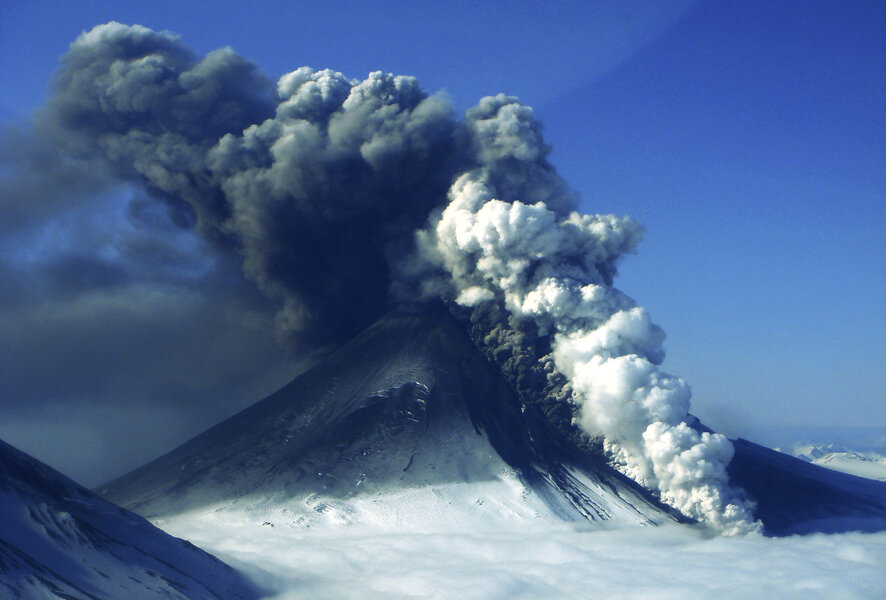Alaska's Pavlof volcano: Did we see this eruption coming?
Loading...
Pavlof Volcano, an active volcano on Alaska’s Aleutian Islands, erupted Sunday at 4:18 pm local time, sending ash up to 20,000 feet in the air.
Eruptions are not a rarity for Pavlof. The well-known volcano, which measures 4.4 miles in diameter, has had 40 other known eruptions. Located about 600 miles southwest from Anchorage, Pavlof “is one of the most consistently active volcanoes in the Aleutian arc,” according to the US Geological Survey (USGS).
With its frequent eruptions, Pavlof has become a model for how the USGS predicts and mitigates volcanic eruptions. Throughout each stage of the eruption process, from prediction to cleanup, partnership between different US agencies and organizations is crucial for volcanic preparation.
The USGS is responsible for monitoring volcanic activity in the US, but direct monitoring of Alaska’s volcanos is carried out by the Alaska Volcano Observatory (AVO), a joint program by the USGS, the University of Alaska Fairbanks Geophysical Institute, and the State of Alaska Division of Geological and Geophysical Surveys.
Because volcanic eruptions can last either weeks or months, scientists at AVO are constantly monitoring Pavlof. To detect early signs of unrest in Pavlof’s vicinity, AVO scientists look for satellite data with a strong thermal signal, a sign of high levels of seismic activity in the area. AVO says they knew Pavlof was close to activity at 3:53 pm – about 25 minutes before the eruption – after witnessing high, continuous tremors.
And while this isn’t much of a heads up, AVO says the post-eruption protocol is what really matters.
After the AVO scientists spotted the signal, they worked with the Federal Aviation Administration (FAA) and the National Oceanic and Atmospheric Administration’s National Weather Service (NOAA NWS) to determine “where ash cloud will drift and what areas may be affected by ash fall.”
“The USGS has developed a new ash cloud dispersal and fallout tool – a computer model known as Ash3d – that is being employed by AVO,” explains USGS. “This numerical model provides information about where, when and the amount of ash fall that is expected to occur for a specified set of eruption source conditions. This information helps guide decisions on whether planes can safely land or depart, health warnings, potential impacts to infrastructure, and even when ash will stop falling and cleanup can begin.”
Because most of Alaska’s active volcanoes are located in remote areas, scientists are primarily concerned about aviation safety and its economic implications.
“Although most of the volcanoes in Alaska are remote and not close to populated areas, millions of dollars of air freight and 20,000-30,000 people fly over active Alaskan volcanoes daily traveling between North America and Asia,” says USGS. “In fact, the Ted Stevens Anchorage International Airport is ranked the fifth busiest air cargo hub in the world based on tonnage.”
And to ensure safe air travel, AVO employs an Aviation Color Code during or immediately after an eruption. Pavlof’s eruption Sunday triggered a Code Red, the highest of four tiers, telling the FAA that “significant emission of volcanic ash into the atmosphere is likely,” or eruption is currently underway.
Twenty-thousand feet in the air is high – but it pales in comparison to previous Pavlof eruptions. The Alaska Volcano Observatory says some eruptions have sent ash up to 49,000 feet in height, drifting more than 300 miles from the site.
The last great eruption, in November 2014, consisted of three separate explosions. On November 12, Pavlof sent ash up to 9,000 feet in the air, followed by a 25,000 ft. eruption on Nov. 15 and a 30,000 ft. eruption on Nov. 16. And the year before, a series of eruptions occurred between May and July of 2013. Following a six-year dormant period, Pavlof began erupting on the morning of May 13, 2013, sending ash between 13,000 and 20,000 feet in the air.
Alaska is home to 52 active volcanoes, 28 of which are monitored with ground-based instruments.








